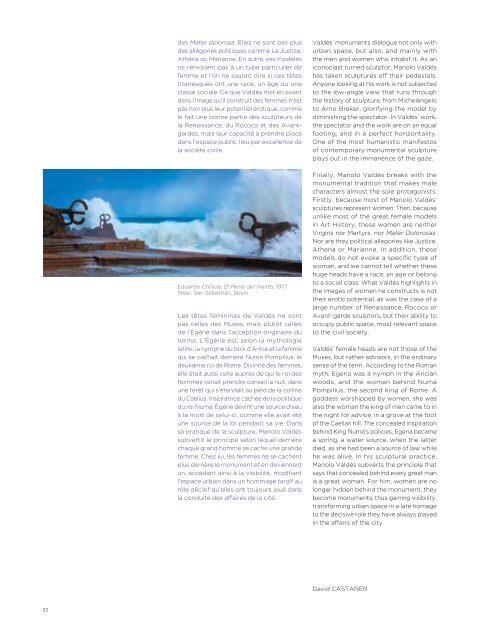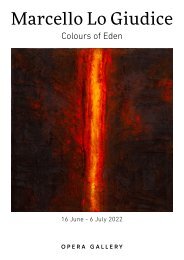Manolo Valdés - Monumentales Egéries
Installation along the Avenue Georges V 15 October 2020 - 15 January 2021 Avenue Georges V, Paris
Installation along the Avenue Georges V
15 October 2020 - 15 January 2021
Avenue Georges V, Paris
You also want an ePaper? Increase the reach of your titles
YUMPU automatically turns print PDFs into web optimized ePapers that Google loves.
des Mater dolorosa. Elles ne sont pas plus<br />
des allégories politiques comme La Justice,<br />
Athéna ou Marianne. En outre, ces modèles<br />
ne renvoient pas à un type particulier de<br />
femme et l’on ne saurait dire si ces têtes<br />
titanesques ont une race, un âge ou une<br />
classe sociale. Ce que <strong>Valdés</strong> met en avant<br />
dans l’image qu’il construit des femmes n’est<br />
pas non plus leur potentiel érotique, comme<br />
le fait une bonne partie des sculpteurs de<br />
la Renaissance, du Rococo et des Avantgardes,<br />
mais leur capacité à prendre place<br />
dans l’espace public, lieu par excellence de<br />
la société civile.<br />
<strong>Valdés</strong>’ monuments dialogue not only with<br />
urban space, but also, and mainly with<br />
the men and women who inhabit it. As an<br />
iconoclast turned sculptor, <strong>Manolo</strong> <strong>Valdés</strong><br />
has taken sculptures off their pedestals.<br />
Anyone looking at his work is not subjected<br />
to the low-angle view that runs through<br />
the history of sculpture, from Michelangelo<br />
to Arno Breker, glorifying the model by<br />
diminishing the spectator. In <strong>Valdés</strong>’ work,<br />
the spectator and the work are on an equal<br />
footing, and in a perfect horizontality.<br />
One of the most humanistic manifestos<br />
of contemporary monumental sculpture<br />
plays out in the immanence of the gaze.<br />
Eduardo Chillida, El Peine del Viento, 1977<br />
Steel, San Sebastián, Spain<br />
Les têtes féminines de <strong>Valdés</strong> ne sont<br />
pas celles des Muses, mais plutôt celles<br />
de l’Égérie dans l’acception originaire du<br />
terme. L’Égérie est, selon la mythologie<br />
latine, la nymphe du bois d’Aricie et la femme<br />
qui se cachait derrière Numa Pompilius, le<br />
deuxième roi de Rome. Divinité des femmes,<br />
elle était aussi celle auprès de qui le roi des<br />
hommes venait prendre conseil la nuit, dans<br />
une forêt qui s’étendait au pied de la colline<br />
du Caelius. Inspiratrice cachée de la politique<br />
du roi Numa, Égérie devint une source d’eau<br />
à la mort de celui-ci, comme elle avait été<br />
une source de la loi pendant sa vie. Dans<br />
sa pratique de la sculpture, <strong>Manolo</strong> <strong>Valdés</strong><br />
subvertit le principe selon lequel derrière<br />
chaque grand homme se cache une grande<br />
femme. Chez lui, les femmes ne se cachent<br />
plus derrière le monument et en deviennent<br />
un, accédant ainsi à la visibilité, modifiant<br />
l’espace urbain dans un hommage tardif au<br />
rôle décisif qu’elles ont toujours joué dans<br />
la conduite des affaires de la cité.<br />
Finally, <strong>Manolo</strong> <strong>Valdés</strong> breaks with the<br />
monumental tradition that makes male<br />
characters almost the sole protagonists.<br />
Firstly, because most of <strong>Manolo</strong> <strong>Valdés</strong>’<br />
sculptures represent women. Then, because<br />
unlike most of the great female models<br />
in Art History, these women are neither<br />
Virgins nor Martyrs, nor Mater Dolorosas.<br />
Nor are they political allegories like Justice,<br />
Athena or Marianne. In addition, these<br />
models do not evoke a specific type of<br />
woman, and we cannot tell whether these<br />
huge heads have a race, an age or belong<br />
to a social class. What <strong>Valdés</strong> highlights in<br />
the images of women he constructs is not<br />
their erotic potential, as was the case of a<br />
large number of Renaissance, Rococo or<br />
Avant-garde sculptors, but their ability to<br />
occupy public space, most relevant space<br />
to the civil society.<br />
<strong>Valdés</strong>’ female heads are not those of the<br />
Muses, but rather advisors, in the ordinary<br />
sense of the term. According to the Roman<br />
myth, Egeria was a nymph in the Arician<br />
woods, and the woman behind Numa<br />
Pompilius, the second king of Rome. A<br />
goddess worshipped by women, she was<br />
also the woman the king of men came to in<br />
the night for advice, in a grove at the foot<br />
of the Caelian hill. The concealed inspiration<br />
behind King Numa’s policies, Egeria became<br />
a spring, a water source, when the latter<br />
died, as she had been a source of law while<br />
he was alive. In his sculptural practice,<br />
<strong>Manolo</strong> <strong>Valdés</strong> subverts the principle that<br />
says that concealed behind every great man<br />
is a great woman. For him, women are no<br />
longer hidden behind the monument, they<br />
become monuments, thus gaining visibility,<br />
transforming urban space in a late homage<br />
to the decisive role they have always played<br />
in the affairs of the city.<br />
Coulisses de l’installation<br />
Avenue George V<br />
Backstage preparations<br />
for the installation<br />
on Avenue George V<br />
David CASTAÑER<br />
22

















